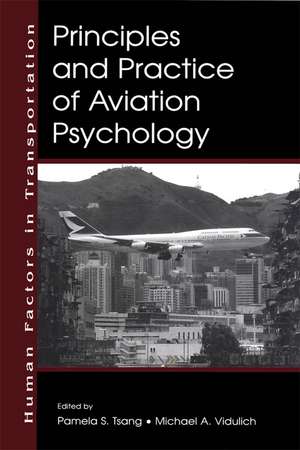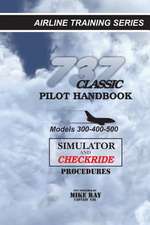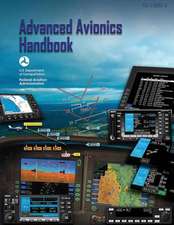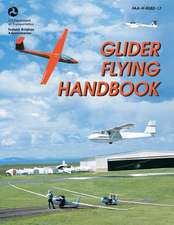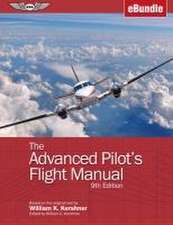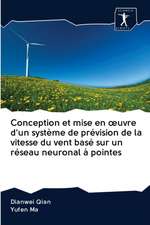Principles and Practice of Aviation Psychology: Human Factors in Transportation
Editat de Pamela S. Tsang, Michael A. Vidulichen Limba Engleză Hardback – aug 2002
Preț: 1143.51 lei
Preț vechi: 1394.53 lei
-18% Nou
Puncte Express: 1715
Preț estimativ în valută:
218.80€ • 228.47$ • 180.68£
218.80€ • 228.47$ • 180.68£
Carte tipărită la comandă
Livrare economică 15-29 aprilie
Preluare comenzi: 021 569.72.76
Specificații
ISBN-13: 9780805833904
ISBN-10: 0805833900
Pagini: 624
Ilustrații: black & white illustrations
Dimensiuni: 152 x 229 x 37 mm
Greutate: 1.44 kg
Ediția:New.
Editura: CRC Press
Colecția CRC Press
Seria Human Factors in Transportation
ISBN-10: 0805833900
Pagini: 624
Ilustrații: black & white illustrations
Dimensiuni: 152 x 229 x 37 mm
Greutate: 1.44 kg
Ediția:New.
Editura: CRC Press
Colecția CRC Press
Seria Human Factors in Transportation
Public țintă
ProfessionalCuprins
Contents: Preface. Foreword. Series Foreword. P.S. Tsang, M.A. Vidulich, Introduction to Aviation Psychology. R.N. Haber, L. Haber, Perception and Attention During Low-Altitude High-Speed Flight. L.R. Young, Spatial Orientation. M.A. Vidulich, Mental Workload and Situation Awareness: Essential Concepts for Aviation Psychology Practice. C.D. Wickens, Aviation Displays. D. O'Hare, Aeronautical Decision Making: Metaphors, Models, and Methods. C.D. Wickens, Pilot Actions and Tasks: Selection, Execution, and Control. R.A. Hess, Pilot Control. R. Parasuraman, E.A. Byrne, Automation and Human Performance in Aviation. T.R. Carretta, M.J. Ree, Pilot Selection Methods. J. Patrick, Training. M.K. Kaiser, J.A. Schroeder, Flights of Fancy: The Art and Science of Flight Simulation. P.J. Sherman, Applying Crew Resource Management Theory and Methods to the Operational Environment. P.S. Tsang, Assessing Cognitive Aging in Piloting.
Recenzii
"I found the book immensely thought provoking and utterly engaging....This outstanding book deserves a place, not on the bookshelf, but open on the desk of any student or professional working in the field of aviation or engineering psychology."
—Ergonomics
"It is a highly useful book for those who wish for a comprehensive overview of a complex topic. It could also serve as a graduate text for aviation psychologists and engineers and as a practical guide for aviation professionals...who need practical guidance when solving aviation problems."
—Ergonomics in Design
"In the middle of the last century, the authors of the first ergonomics textbook (Chapanis, Garner, & Morgan, 1949) were wrestling with many aspects of a new field ... At the beginning of a new century, Tsang and Vidulich offer an edited volume of 14 chapters presenting the tough problems and the principles relevant to solving them."
—F.T. Durso, J.I. Norris, A.R. Dattel
The International Journal of Aviation Psychology
—Ergonomics
"It is a highly useful book for those who wish for a comprehensive overview of a complex topic. It could also serve as a graduate text for aviation psychologists and engineers and as a practical guide for aviation professionals...who need practical guidance when solving aviation problems."
—Ergonomics in Design
"In the middle of the last century, the authors of the first ergonomics textbook (Chapanis, Garner, & Morgan, 1949) were wrestling with many aspects of a new field ... At the beginning of a new century, Tsang and Vidulich offer an edited volume of 14 chapters presenting the tough problems and the principles relevant to solving them."
—F.T. Durso, J.I. Norris, A.R. Dattel
The International Journal of Aviation Psychology
Notă biografică
Pamela S. Tsang, Michael A. Vidulich
Descriere
Covering field history and discussing actual modern-day pilot actions and tasks, the editors of this volume have integrated contributions from leaders in aviation to present psychological principles and research pertinent to the interface between a pilot and the cockpit. The book addresses the pilot’s cognitive demands, capabilities, and limitations, which have important implications for operator selection and training as well as display/control designs in the cockpit. It emphasizes scientific methods of achieving this understanding and implies that theories and principles of human behavior are shaped and improved by practical problems and applied studies.
